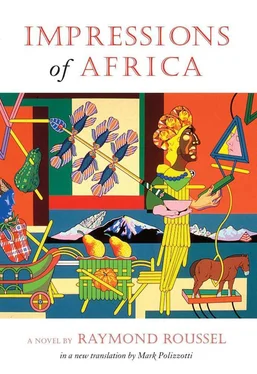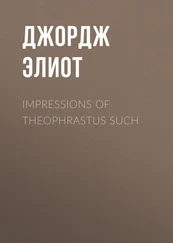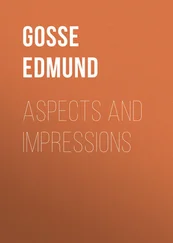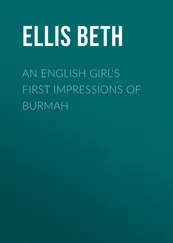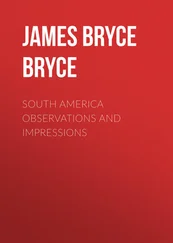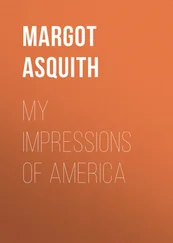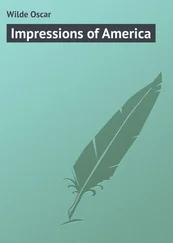Readers wishing further insights into Roussel’s life, work, and creative method are encouraged to explore Mark Ford’s illuminating study, Raymond Roussel and the Republic of Dreams (2000), from which I’ve borrowed a number of biographical pointers. In the domain of English-language commentary, John Ashbery’s essays “Re-establishing Raymond Roussel” (1962) and “In Darkest Language” (1967) remain the gold standard some fifty years after the fact, though they have since been seconded by essential writings from Harry Mathews and Trevor Winkfield. And of course, Roussel’s own How I Wrote Certain of My Books (trans. Winkfield) is a must. The present translation of Impressions of Africa is based on the 2005Flammarion edition, edited and annotated by Tiphaine Samoyault, which also provided some source material for this introduction. To all of the above, my gratitude.
— MP, December 2010
AT AROUND FOUR P.M. that June 25th, everything seemed ready for the coronation of Talou VII, Emperor of Ponukele and King of Drelchkaff.
Though the sun had passed its zenith, the heat remained stifling in that region of equatorial Africa, and we all sweltered in the sultry atmosphere that no breeze came to relieve.
Before me stretched vast Trophy Square, located in the very heart of Ejur, the imposing capital formed by countless huts and lapped by the Atlantic Ocean, whose distant roar I could hear to my left.
The perfect quadrangle of the esplanade was bordered on each side by a row of venerable sycamores. From spears planted deep into the bark of each trunk dangled severed heads, banners, and ornaments of every kind, which Talou VII or his ancestors had amassed there upon returning from many a victorious campaign.
To my right, before the midpoint of the row of trees, a red stage stood like a giant puppet theater; its pediment bore the words “The Incomparables Club” in silver letters forming three lines, around which broad golden strokes radiated like sun’s rays.
On the visible stage, a table and chair appeared to be set for a lecturer. Several unframed portraits were pinned to the backdrop, underscored by an explanatory label that read “The Electors of Brandenburg.”
Closer to me, in line with the red theater, rose a large wooden pedestal on which Nair, a young Negro of barely twenty, was standing doubled over, absorbed in an engrossing task. To his right, two stakes, each planted at a corner of the pedestal, were joined at their uppermost tips by a long, supple thread that sagged under the weight of three objects hanging in a row, displayed like fairground prizes. The first item was none other than a bowler hat, the black crown of which bore the word “PINCHED” written in dirty white capitals; then came a dark gray suede glove turned palm outward and decorated with a “C” lightly traced in chalk; and last hung a light sheet of parchment covered in obscure hieroglyphs, its header boasting a rather crude sketch of five caricatures made plainly ridiculous by their poses and exaggerated features.
Imprisoned on his pedestal, Nair’s right foot was collared by a noose of thick rope firmly anchored to the solid platform; like a living statue, he performed a series of slow, regular movements while rapidly murmuring a string of words he’d committed to memory. In front of him, placed on a specially shaped stand, a fragile pyramid fashioned from three joined pieces of bark captured his full attention; the base, turned toward him and slightly raised, served as his weaving loom. Within reach, on an annex to the base, was a supply of fruit husks covered on the outside by a grayish vegetal substance much like the cocoon of a larva about to transform into a chrysalis. By pinching a fragment of these delicate envelopes with two fingers and slowly pulling back his hand, the youth created a flexible bond, reminiscent of the gossamer threads that stretch across the woods in springtime. These imperceptible strands helped him weave a subtle and complex embroidery, for his two hands worked with unparalleled agility, crossing, knotting, intermingling the fairylike ligatures into graceful patterns. The phrases he tonelessly recited served to regulate his perilous and precise maneuvers, for the smallest slip could have caused the whole structure irreparable damage. If not for the aid of a certain formula memorized word for word, Nair could never have reached his goal.
Lower down, to the right, other toppled pyramids at the edge of the pedestal — their tips facing away from the viewer — allowed one to appreciate the effect of these labors, once completed; each upright base was indicated by almost nonexistent tissue, more ephemeral than a spider’s web. In each, a red flower held by its stem irresistibly drew the viewer’s gaze through the imperceptible veil of the ethereal weave.
Not far from the Incomparables’ stage, to the actor’s right, two stakes set four to five feet apart supported a moving apparatus. A long pivot extended from the nearer of the two, around which a scroll of yellowed parchment was compressed into a thick roll; solidly nailed to the farther stake, a square board laid as a platform served as base for a vertical cylinder slowly made to revolve by clockwork.
The yellowish scroll, unspooling tautly over the entire length of the intervening gap, wrapped around the cylinder, which, turning on its axis, ceaselessly pulled it toward the other side, gradually depleting the pivot that was forced to spin along with it.
The parchment showed groups of savage warriors, rendered in broad strokes, parading by in highly varied poses. One cohort seemed to be in mad pursuit of the fleeing foe; another, crouching behind an embankment, awaited its moment to burst forth; here, two equally matched phalanxes engaged in fierce hand-to-hand combat; there, fresh troops surged bravely forward with grand gestures toward a distant melee. The continual procession offered endless surprises, owing to the infinite number of effects obtained.
Opposite, at the far end of the esplanade, rose a kind of altar preceded by several steps covered with a thick carpet. From a distance, a coat of white paint veined with bluish lines gave the whole the appearance of marble.
On the Communion table, represented by a long board placed halfway up the structure and covered with a cloth, one could see a rectangle of parchment dotted with hieroglyphics standing near a heavy cruet full of oil. Next to this, a large sheet of stiff luxurious paper bore the title, “Reigning House of Ponukele-Drelchkaff,” written scrupulously in Gothic letters. Beneath this heading, a round portrait, a kind of delicately colored miniature, depicted two young Spanish girls aged thirteen or fourteen, coiffed in the national mantilla — twin sisters, judging by their perfect resemblance. At first glance, the image seemed part and parcel of the document; but upon closer inspection, one noticed a wide band of transparent muslin, glued onto both the circumference of the painted disk and the surface of the durable vellum, that melded the two objects seamlessly, though they were in fact separate. To the left of the dual effigy, the name “SUANN” paraded in large capitals; beneath it, a genealogical chart comprising two distinct branches, descended from the two lovely Iberians who formed the apex, occupied the rest of the sheet. One of these lineages ended with the word “Extinction,” in letters almost as large as the title, clearly meant to catch the eye; by contrast, the other, stretching a bit lower than its neighbor, seemed to defy the future with the absence of any concluding sign.
Near the altar, to the right, a giant palm tree flourished, its admirable breadth attesting to its great age; a handwritten sign affixed to the trunk offered this commemorative phrase: “Restoration of the Emperor Talou IV to the throne of his forefathers.” Off to one side and sheltered by the palms, a stake planted in the ground supported a soft-boiled egg on the square ledge of its upper tip.
Читать дальше
